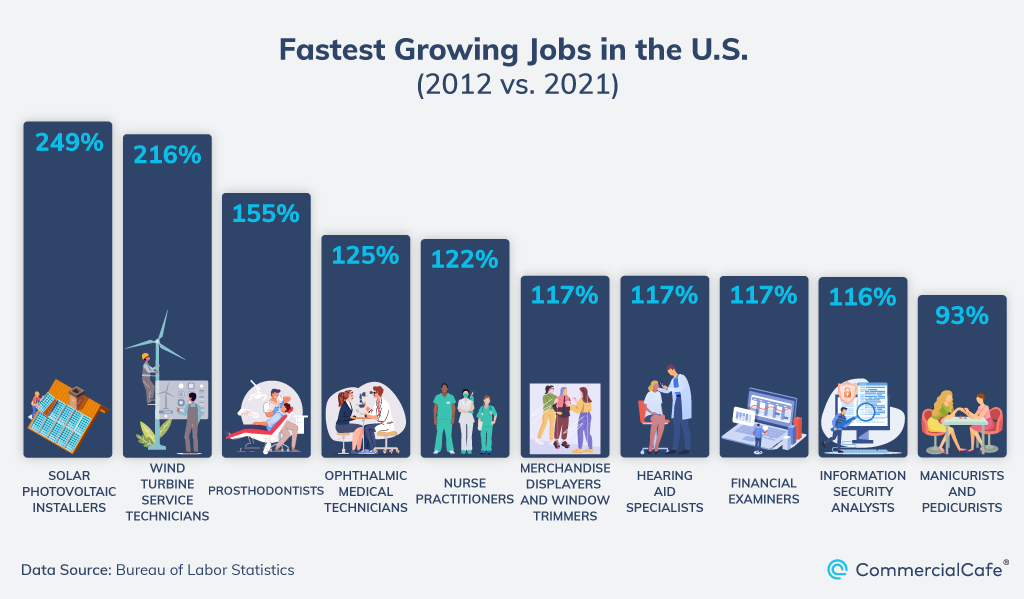Key Highlights:
- Solar and wind jobs tripled during last 10 years
- Healthcare accounted for top job growth in 11 states
- Engine and machine assembly jobs quadrupled in Indiana
- Number of fast food workers in North Carolina jumped by a whopping 1,705%
- More than half of U.S. jobs in 2021 were in business or healthcare
The events of the last decade — and, more recently, the effects of the COVID-19 pandemic — brought about a number of important changes within the U.S. labor market. In addition to providing a major boost to the remote and hybrid work models, the last couple of years also acted as a catalyst for developments that had been building up for more than 10 years.
Specifically, the U.S. labor market was already undergoing an important expansion of its health sector in an effort to provide care for one of the largest cohorts of retirees. Accordingly, by 2021, the number of Americans working in healthcare-related jobs was roughly 20 million. Meanwhile, the green energy sector — which had been steadily growing throughout the course of the last decade — is now receiving more attention as an important source of new jobs for both blue- and white-collar workers.
So, to better understand the pace and extent of these changes, we used the latest data from the Bureau of Labor Statistics (BLS) to discover the fastest-growing caareers across the U.S. during the last decade. We also mapped the dominant industry for each of the 48 states in the contiguous United States, according to both percentage share and total number employees in a given occupation. Keep reading for more insights.
Solar Jobs More Than Triple in 10 Years
With so much of today’s economy revolving around the energy sector, it’s only fitting that one of the fastest-growing careers (by percentage share) during the course of the decade was that of photovoltaic installers. This trade experienced a massive 249% jump in the surveyed period.
For context, in 2010, solar power delivered roughly 1.2 million megawatt hours (MWH) to the U.S. energy market. Then, by 2020, output for this renewable energy source had grown to 91 million MWH. Naturally, this evolution is reflected in the numbers of professionals in this occupation, which grew from just 4,710 in 2012 to roughly 16,420 last year.
We see a similar picture in the case of the second-fastest-growing job: The number of wind turbine service technicians increased from 3,200 at the beginning of the surveyed period to 10,100 by the end for a 216% hike. Here again, the industry added the largest number of professionals during the pandemic, as employment in this field nearly doubled year-over-year.

Meanwhile, as documented in our previous studies, various professions in the healthcare sector have consistently been among the fastest-growing careers in the U.S. That said, of the four occupations that made the top 10 in terms of their growth percentage, prosthodontists stood out with a 155% hike in the last 10 years.
Overall, increases in the ranks of ophthalmic medical technicians, nurse practitioners and hearing aid specialists ranged between 117% and 125%. That then translated into impressive employment numbers due to the shares that these occupations already had within the labor market. As an example, the number of nurse practitioners swelled more than two-fold during the last 10 years to 234,690 workers.
However, not all increases are created equal: Any new jobs added to the market for occupations that have only a few hundred or thousand employees across the entire nation can result in significant percentage swings in 10 years. For instance, while prosthodontists witnessed a 155% surge, that industry total only grew from 310 in 2012 to 790 in 2021.
Healthcare Jobs Record Highest Employment Increase Across 11 States; Michigan Leads List with 678% Spike
Below is a map showing which jobs — and industry they pertain to — grew the most in each state in the last decade. Hover over the states to see the fastest-growing job in each one.
When broken out by industry type at the state level, we can see that the fastest-growing occupations were within the healthcare, industrial and business sectors.
In particular, healthcare-related jobs topped the list in terms of percentage growth in the last 10 years in 11 states. The largest leap among these was in Michigan, where the ranks of ophthalmic medical technicians swelled by 678% since 2012. That translated into an additional 1,830 new jobs. Arizona was another state in which this profession grew significantly, albeit by a smaller margin (603%).
Similarly, Illinois boasted a 670% increase in the last decade to add an extra 2,210 marriage and family therapists to the state’s workforce. Meanwhile, manicurist and pedicurists jobs (which also fall under the broader category of healthcare occupations) topped the list across three states: Texas, Colorado and Wisconsin. In terms of total number of people employed in the profession, their ranks grew sixfold in Texas — from 1,150 to 6,610.
Indiana Engine & Machine Assembly Jobs Quadruple
At the same time, industrial occupations witnessed the most significant increases in eight states, including South Carolina (376%) and Virginia (350%). Even so, it was a 432% jump in engine and machine assemblers in Indiana that really stood out, adding 7,130 jobs throughout the last decade.
In California, it was a transportation industry job that grabbed the spotlight: The ranks of airfield operations specialists swelled by 560% here — from 480 to 3,170 workers by 2021.
Interestingly, Maryland and Georgia were the only states in which occupations relating to farming recorded the most significant increases. The number of farmworkers and laborers grew by 287% in Maryland (from 600 to 2,320), while Georgia agricultural equipment operators reached 940 workers, following a 276% hike.
North Carolina Claims 18 Times More Fast Food Workers; Florida & New York Add Most Business Jobs of Decade
Service jobs — especially restaurants and entertainment establishments — took a major hit in 2020 as many people avoided activities that required face-to-face, indoor interactions, even after restrictions and lockdowns were lifted. Dire circumstances notwithstanding, the growth has been impressive. For example, in North Carolina, fast food cooks headed the list of fastest-growing service jobs (1,705%). Their total number of workers was 18 times higher than it was at the start of the decade and more than triple that of the state’s pre-pandemic high.
Additionally, with both Millennials and now Gen Z focusing on education, the need for people who can process admission paperwork, oversee student activities and manage faculty research has grown. To that end, in Florida, the number of education administrators was 10 times higher by the end of the decade, reaching 13,660 workers — the highest spike for occupations within the business sector, both in terms of percentage and number of employees. The runner-up was New York, where employment for financial examiners went up 538%: The Empire State added more than 11,000 new jobs to the market in the last decade.
The table below details each state’s fastest-growing profession (by percentage), including the difference in the numbers of employees in 2012 and 2021.
More Than Half of Working Americans Employed in Business or Healthcare Jobs
The maps below are interactive. First, select the industry or a group of industries on the right. The top map shows the share held by each of the 11 industries across job markets at state level. The bottom map reflects the total number of employees in a certain industry.
Notably, business, industrial and healthcare jobs made up the largest shares of the overall labor market in the U.S., totaling roughly 97 million workers employed across these three major sectors. According to BLS data, just more than half of working Americans were employed in a healthcare or business-related job in 2021.
Notably, Wyoming was the only state in which business jobs fell just below the 30% threshold, whereas Florida, New Hampshire and Utah boasted the highest shares of workers in this industry. Meanwhile, in the South, occupations in the transportation sector claimed the largest share of the workforce in Tennessee, Kentucky, and Arkansas, while one-quarter of the workforce in Wyoming, Indiana and Alabama were employed in industrial jobs.
Analyzing industries in each state by number of people employed, the concentration of jobs in the coastal and Sun Belt regions during the last decade becomes quite apparent: A combination of four states — California, Texas, Florida and New York — repeatedly topped the rankings for the most workers within the industrial, education, healthcare and IT sectors.
Searching for a workplace that suits your business needs? CommercialCafe.com provides you with a reliable and up-to-date database of listings from all major U.S. markets.
Methodology
- Data was collected from BLS Occupational Employment Statistics in 2012 and 2021.
- Occupations that had less than 250 positions by state in 2012 were excluded.
- Occupations with a BLS suffix of “All Other” were excluded.
- Our analysis included the 48 states, defined as the contiguous United Sates. The term excludes the states of Alaska and Hawaii, along with all other offshore, insular areas, such as American Samoa, Guam, the Northern Mariana Islands, Puerto Rico and the U.S. Virgin Islands.









